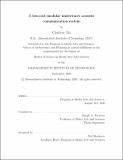| dc.contributor.advisor | Joseph A. Paradiso. | en_US |
| dc.contributor.author | Xia, Charlene. | en_US |
| dc.contributor.other | Program in Media Arts and Sciences (Massachusetts Institute of Technology) | en_US |
| dc.date.accessioned | 2021-05-14T16:27:52Z | |
| dc.date.available | 2021-05-14T16:27:52Z | |
| dc.date.copyright | 2020 | en_US |
| dc.date.issued | 2020 | en_US |
| dc.identifier.uri | https://hdl.handle.net/1721.1/130598 | |
| dc.description | Thesis: S.M., Massachusetts Institute of Technology, School of Architecture and Planning, Program in Media Arts and Sciences, September, 2020 | en_US |
| dc.description | Cataloged from the official PDF version of thesis. | en_US |
| dc.description | Includes bibliographical references (pages 99-102). | en_US |
| dc.description.abstract | This thesis describes the design of a novel modular acoustic communication device for underwater wireless communication. The ocean plays a vital role in the global climate system and biosphere, providing a wealth of biodiversity and resources. Human exploitation, pollutants, and contaminants have already impacted the deepest trenches of the ocean. Yet most of this impact remains invisible - the depth and breadth of the ocean, the opacity of water to light, and the lack of mass-deployable ocean instrumentation, mean that current observations are wildly under sampled in space and time. Even given suitable instruments, a major challenge remains: how to get the data home. Given the opacity of sea water to radio, and the complexity and expense of underwater cabling, audio communication is in may ways the low hanging fruit. Unfortunately, most commercial audio communication systems are both extremely expensive and more powerful than needed for many, if not most, monitoring requirements. | en_US |
| dc.description.abstract | They are also proprietary, a frustrating barrier to development of novel devices. As a result, these off-the-shelf systems are ill-suited to the global multi-scale instrumentation challenges of the future. In what follows we document the design, development, and testing of a low-cost, high-efficiency, modular, and fully open-sourced acoustic communication system. This system is specifically intended for mass deployment, with particular emphasis on standardized hardware and software interfaces. Crucially, this design prioritizes cost and simplicity over performance - as such, this system does not aim to replace the current crop of commercially available systems, but rather to provide a new kind of tool specifically for scalable deployments of low-cost instruments. | en_US |
| dc.description.abstract | Functionally, the system is composed of three core modules: a power management unit; a central processing unit; and a family of interchangeable acoustic transceiver units operating across a spectrum of transmission frequencies. The resulting design should be of valuable use to the scientific community, environmental agencies, citizen scientists, and anyone who needs to transport low-bandwidth data through the ocean at extremely low cost. | en_US |
| dc.description.statementofresponsibility | by Charlene Xia. | en_US |
| dc.format.extent | 102 pages | en_US |
| dc.language.iso | eng | en_US |
| dc.publisher | Massachusetts Institute of Technology | en_US |
| dc.rights | MIT theses may be protected by copyright. Please reuse MIT thesis content according to the MIT Libraries Permissions Policy, which is available through the URL provided. | en_US |
| dc.rights.uri | http://dspace.mit.edu/handle/1721.1/7582 | en_US |
| dc.subject | Program in Media Arts and Sciences | en_US |
| dc.title | A low-cost modular underwater acoustic communication system | en_US |
| dc.type | Thesis | en_US |
| dc.description.degree | S.M. | en_US |
| dc.contributor.department | Program in Media Arts and Sciences (Massachusetts Institute of Technology) | en_US |
| dc.identifier.oclc | 1249942767 | en_US |
| dc.description.collection | S.M. Massachusetts Institute of Technology, School of Architecture and Planning, Program in Media Arts and Sciences | en_US |
| dspace.imported | 2021-05-14T16:27:52Z | en_US |
| mit.thesis.degree | Master | en_US |
| mit.thesis.department | Media | en_US |
